 Plutonium “pit” production at SRS, for nuclear weapons? Is the
Plutonium “pit” production at SRS, for nuclear weapons? Is thePentagon driving the train to build the plutonium core of US nuclear weapons at SRS ? Article with SRS Watch (based on our news release of December 6, 2017)
Document: DOE considering SRS as site to build nuclear weapons components
Aiken (South carolina) Standard, December 8 , 2017
—–
On December 6, 2017, the South Carolina Office of Rubber Stamp (ORS) quietly released – not sent to the public – documents about “what they knew & when they knew it” – about SCE&G’s VC Summer nuclear debacle. ORS knew years ago that the project was in the ditch, with no chance of meeting the stated schedule (this was known at the time by anyone watching the train wreck go into the ditch)
Why did they hide these documents from the public and why didn’t they turn over to the South Carolina Public Service commission and such intervenors as Friends of the Earth and the Sierra Club?
see documents from 2015-2017:
—–

“FURTHER CONTINUING APPROPRIATIONS
5 ACT, 2018” to fund the federal government from December 8 to December 22 likely to be passed on Thursday, December 7, with the Children’s Health Insurance Program (CHIP) being partially funded. The current CR, which has funded the government in Fiscal Year 2018 (began on October 1), expires on December 8.
So, SRS programs will continue at last year’s level and the MOX debacle – management, worker, design and construction problems and all – limps along for another two weeks.
https://www.gpo.gov/fdsys/pkg/BILLS-115hjres123ih/pdf/BILLS-115hjres123ih.pdf
—–

Report shows LANL competing with South Carolina site for [plutonium] pit production beyond 2026
Sante Fe New Mexican, December 5, 2017
article linked here
—–
Good to see this after so many years opposing Japan’s plutonium- proliferation project:
Operator submits 30-yr plan to scrap trouble-prone Monju [plutonium breeder] reactor in Japan
Kyodo, via Nikkei Asian Review, December 6, 2017
See Japan’s communication to the IAEA on its massive plutonium stockpile, via Information Circular 549, September 8, 2017 – over 40 metric tons stockpiled in Japan and Europe, due to a dedicated program to stockpile as much weapon-usable plutonium as possible, via reprocessing of spent nuclear fuel – expensive, unjustifiable nuclear proliferation madness! It’s past time to officially halt the Rokkasho reprocessing plant (a la Monju termination).
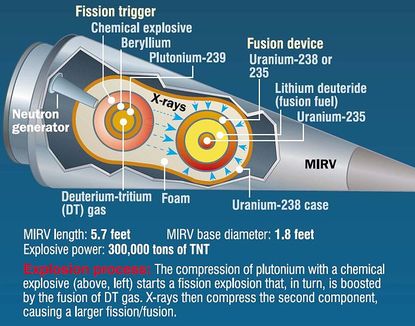
Is the Savannah River Site being secretly eyed for production of plutonium “pits” for nuclear weapons? Rumors have been circulating all year that the soon-to-be-abandoned MOX plant is being reviewed for that dubious mission. Recall that the “Modern Pit Facility” (MPF), planned for SRS or another DOE site, designed to produce something like 250 pits/year, was defeated over a decade ago. The public near SRS pushed back then against DOE’s secret plans to turn SRS into a major nuclear bomb site. Will that happen again?
“It’s Los Alamos v. South Carolina site for making ‘pits’”
edited title: “Senators: Keep ‘pit’ making at Los Alamos”
December 4, 2017 – Albuquerque (New Mexico) Journal
See DOE news release of January 28, 2004: “NNSA Delays Modern Pit Facility Environmental Impact Statement and Selection of a Preferred Location” – linked here
—–
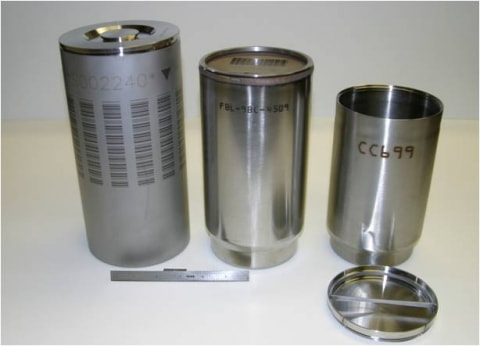
Surveillance and Monitoring Program Full-Scale Experiments to Evaluate the Potential for Corrosion in 3013 Containers
Los Alamos National Lab, November 21, 2017
Conclusion
A series of Pu-bearing test materials containing high and low concentrations of magnesium and calcium chloride salts has been loaded in full-scale tests (instrumented 3013 containers with 2,500 g of material). The test materials have been exposed to a moist air atmosphere to simulate conditions in the Hanford C-line gloveboxes. The Low Ca, Low Mg, High Ca and PMAXBS test materials are inferred to have formed liquid phases, based on the total weight gain, the hydration properties of the AEC salt components present in the materials, and the conditions to which the materials were exposed. The conditions inside the 3013 containers in which these materials were loaded continued to support the formation and persistence of liquid phases during storage. However, liquid phases would not form in the High Mg test material, based on the low relative humidity during exposure and storage.
etc.
photo: inner and outer 3013 plutonium storage container, DOE photo
—-
Nuclear weapons plutonium “pit” production being considered at SRS? In soon-to-be-abandoned MOX plant?
Leaked report casts doubt on LANL pit production
Sante Fe New Mexican, December 1, 2017
The MOX project at SRS is already facing monumental staff turnover and training issues. If workers hear that SRS is seriously being considered for pit production watch yet more MOX workers jump off the sinking ship.
—–
Massive financial liability due to high-level liquid nuclear waste at SRS and Hanford:
DOE “Special Report,” December 1, 2017 – “Management Challenges at the Department of Energy – Fiscal Year 2018,” by DOE’s Inspector General
“Despite billions spent on environmental cleanup, the Department’s environmental liability has roughly doubled from a low of $176 billion in FY 1997 to the FY 2016 estimate of $372 billion. The Department is responsible for 83%, of the Federal government’s $447 billion FY 2016 reported environmental liability which is mostly related to nuclear waste cleanup. Half of the Department’s environmental liability resides at the Hanford Site in Washington State and the Savannah River Site in South Carolina.”
IG’s report linked here:
https://energy.gov/sites/prod/files/2017/11/f46/DOE-OIG-18-09.pdf
—–
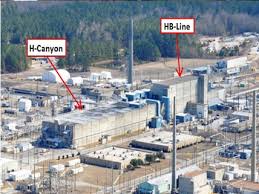
Defense Nuclear Facilities Safety Board (DNFSB) confirms safety of H-Canyon reprocessing plant “exhaust tunnel” being reviewed – in November 3, 2017 weekly report (posted on November 22)
“H-Canyon Exhaust (HCAEX) Tunnel: SRNS is now planning to have an independent review of the SRNL analysis and conclusions by academic professionals. SRNS currently plans to have the report issued by December 5, 2017.”
DNFSB weekly report linked here:
The exhaust tunnel is aging and has suffered deterioration of its structure. Would radioactive materials be released in the event of an earthquake during reprocessing (of spent research reactor fuel)?
>>> Information such as this underscores the important role that the DNFSB plays. In addition to its important safety oversight role, directed by law, the small amount of information provided to the public by the DNFSB is often much more than DOE releases out its black box. Thank you DNFSB and to Members of Congress who are working to protect it from budget cuts and elimination!
—–
South Carolinians Against Monetary Abuse (SCAMA) nuke news, November 20, 2017
In Emergency Petition, SCAMA Requests SC Public Service Commission and Office of Regulatory Staff Direct SCE&G to Immediately Show Charge on Monthly Bill for Failed Nuclear Project, as Line Item
Nine Baseload Review Act Rate Hikes, Totaling 18% of Bill, Must Clearly be Shown, Says SCAMA
SCAMA’s Emergency Petition, with Request for Expedited PSC Action: https://tinyurl.com/y78l5s5t
Columbia, SC – South Carolinians Against Monetary Abuse (SCAMA) today is filing a formal emergency request seeking to force South Carolina Electric and Gas (SCE&) to show the charge for the abandoned V.C. Summer nuclear construction project on the monthly power bill. Currently, the cost of the failed nuclear project is kept off the bill by SCE&G in order to deceive customers about the monthly cost of the failed project, according to SCAMA.
full news release: https://drive.google.com/file/d/1nfCRTRYRCw97ZAGoSzmwf-Gi8TT70ze_/view
—–
Government Accountability Office (GAO) affirms that the $17.2 billion estimate for the plutonium fuel (MOX) plant construction is accurate. This stunning cost estimate for the MOX boondoggle is but one reason that the Trump administration is sticking with the effort to terminate this unsustainable project
See GAO report released on November 16, 2017:
“Plutonium Disposition: Observations on DOE and Army Corps Assessments of the Mixed Oxide Fuel Fabrication Facility Contract”
“DOE developed a revised cost estimate of approximately $17.2 billion to complete construction of the MOX facility by 2048. We reported in September 2017 that the DOE construction cost estimate did not fully meet all of the best practices in the GAO cost-estimating guide, but it substantially met all four characteristics of a high-quality, reliable cost estimate (comprehensive, well documented, accurate, and credible) and therefore could be considered reliable.” (page 1)
GAO website with summary of report – linked here
Stay tuned for the next GAO report – on MOX contractor compliance with DOE regulations.
—–
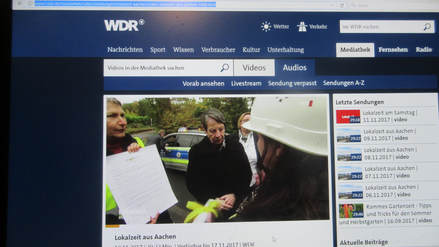
See German TV interview of November 10, 2017, at which time a statement against the export and dumping at SRS from SRS Watch was presented to the Bundesumweltministerin.
Report on WDR-TV, from Aachen, Germany, about the demonstration at the entrance of the Juelich research center, which Hendricks visited as part of her attendance at the Bonn climate change summit – “Mahnwache gegen Castortransporte in Jülich” – see beginning of video (in German):
http://www1.wdr.de/mediathek/video/sendungen/lokalzeit-aachen/video-lokalzeit-aus-aachen-1448.html
—-

Nov. 9, 2017 presentation to SC Public Service Commission linked here
SCE&G to notify US Nuclear Regulatory Commission by December 15, 2017 about plans to abandon license – see letter to NRC here
Photo: VC Summer nuclear scrapyard, October 4, 2017,
©High Flyer; more photos linked here—–
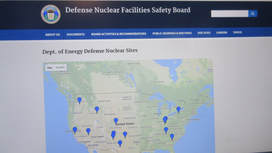
“Energy undersecretary wants nuclear safety reports hidden from public”
Center for Public Integrity, Nov. 9, 2017 – article linked here
Example of what DOE aims to suppress – DNFSB weekly report for SRS, October 6, 2017 – linked here
DNFSB website: https://www.dnfsb.gov/
—-
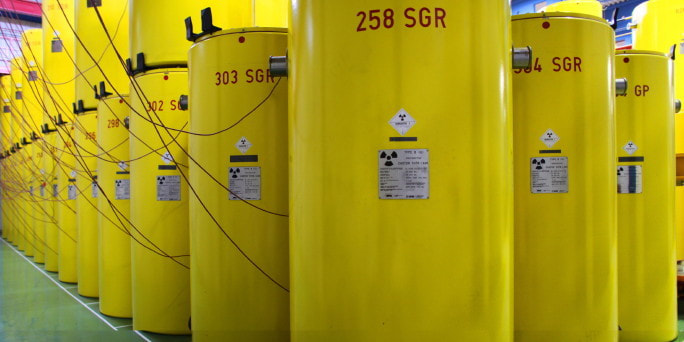
Statement by SRS Watch against the dumping scheme to be handed to German environment minister
German news release: “10.11.2017: Mahnwache vor dem Forschungszentrum Jülich • Übergabe eines Statements an Hendricks geplant” – linked here
SRS Watch statement linked here & on German site linked above
Note: In violation of sound nuclear non-proliferation policies, DOE is adamantly refusing to prepare a “nuclear non-proliferation risk assessment” on the new reprocessing techniques being developed to reprocess the German graphite spent fuel balls. Those backing the dumping-for-profit scheme hope they can continue to violate non-proliferation norms while they make from $800 million to $1 billion or more on the scheme. (These figures were admitted by a representative of the shipping company, Edlow International at an October 12, 2017 meeting of the South Carolina Nuclear Advisory Council. Follow the money to find out why this dumping scheme is still alive.)
photo: Castor casks in storage at Jülich. The casks contain AVR irradiated graphite spent fuel balls; SRS Watch director has visited the storage facility and seen the casks. A new storage facility at the site must be constructed.
—–
Friends of the Earth news release, November 9, 2017:
South Carolina Public Service Commission Set to Hear SCE&G’s “Motion to Dismiss” Friends of the Earth/Sierra Club Complaint on Failed V.C. Summer Nuclear Reactor Project
—–
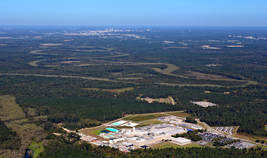
Photos can be used with credit to High Flyer – read the message about use of the photos and see the new photos here:
—–
“Nuclear leak sends worker fleeing to shower”
article on accident at Westinghouse nuclear fuel plant in Columbia, South Carolina
The State, October 25, 2017 print edition
—–
“‘Enough is enough’ nuclear waste”
Re: a failed dumping-for-profit scheme to import highly radioactive spent fuel from Germany, to be processed and dumped at SRS
Charleston (South Carolina) Post & Courier editorial, October 8, 2017
—-

Construction of a Westinghouse experimental AP1000 reactor was halted on July 31, 2017 after SCE&G and it’s partner Santee Cooper (S.C. Public Power Authority) wasted $9 billion. Warnings about the boondoggle were repeatedly made by Friends of the Earth and the Sierra Club since 2008, when the project was reviewed by the S.C. Public Service Commission. Regulators and politicians were in the pocket of SCE&G and did not start paying attention until Westinghouse declared bankruptcy on March 29, 2017.
If you say “They told you so!” you would be 100% correct!
—–
“Along Savannah River, Nuclear Depot Eyed Warily Despite Safety Assurances”
Courthouse News, October 2, 2017, article linked here
—–
“Group opposes bringing German nuclear material through Charleston to Savannah River Site”
Charleston (South Carolina) post and Courier, September 26, 2017 – article linked here
—–
South Carolina Attorney General’s opinion – rip-off law that enabled V.C. Summer reactor construction debacle may not be constitutional:
September 26, 2017
“Opinion on constitutionality of the Base Load Review Act of 2007. Requested by The Honorable G. Murrell Smith, Jr., Leon E. Stavrinakis, J. Gary Simrill, and James E. Smith, Jr., Members, South Carolina House of Representatives.”
—–